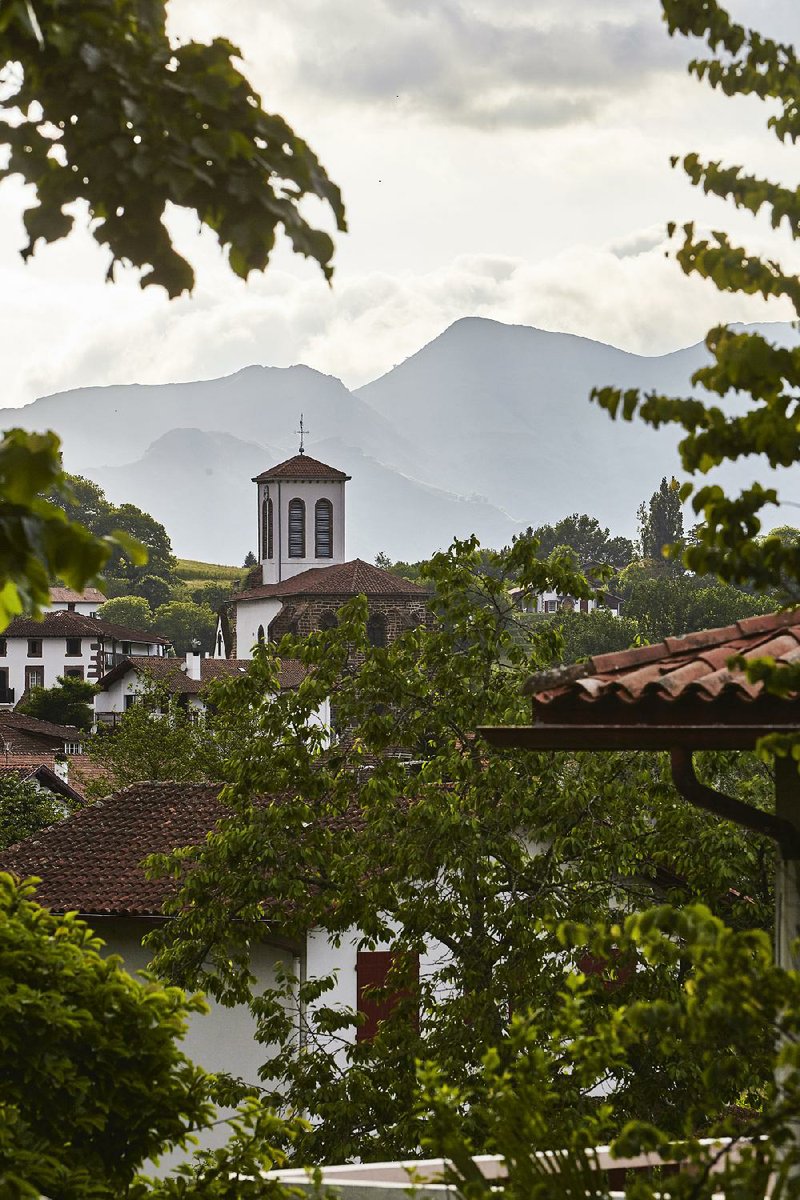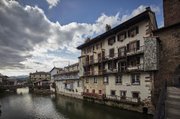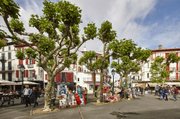On a late Sunday morning, in the French fishing village of Ciboure, townspeople poured out of L'Eglise St.-Vincent, a 16th-century church with an octagonal tower. Some stopped to chat by a tall gray cross speckled with lichen. A young man tended to his stooped grandfather. Freshly coiffed women with short-handled pocketbooks lingered in the courtyard. "Bonne journee," called the priest to his congregation as they headed off into the narrow streets.
I was passing through Ciboure en route to St.-Jean-de-Luz with my friend Gabriella Ranelli, whom I'd persuaded to leave her adopted home in the Spanish Basque Country where she organizes customized tours to poke around in the French part with me.
When most people think of the Basque Country, they think of Spain. Bilbao began the so-called Guggenheim effect. San Sebastian has all those Michelin stars. And Pamplona lets bulls run through its streets once a year. But the Basque Country is made up of seven provinces, three of which are in southwestern France.
The Basques are an ancient people who have inhabited this territory for thousands of years. Today, the Spanish part is an autonomous region with a Basque government, while the French part answers to the central government in Paris. The Spanish side has had a strong independence movement, which has lately been eclipsed by Catalonia's.
"In France, they are also proud of being Basques," a Basque friend from Spain explained, noting, however, that "in Spain, there are many Basques who are willing to be an independent country. In France, very few people think the same."
The French part gets overshadowed by the bounty of Spain and the sunny Provencal olive-branch images of the South of France; it's the little sister who did not get invited to the dance.
...
When we drove across the French border into the province of Labourd, heading north from Gipuzkoa, the landscape changed. Green hills gave way to the craggy foothills of the Pyrenees. The beach towns of the sometimes steep and rocky coast, from modest Ciboure to glamorous Biarritz, sat less than 10 miles from unspoiled mountain villages. Turreted chateaus hid among tall trees. And there were sheep everywhere.
We were on a three-day trip into the French Basque Country. That's Iparralde, which means "the north country" in Euskara, the ancient Basque language that many scholars say is unrelated to any other. It's a tiny land with a population of less than 300,000 (about 2 million live in Basque Spain), and its own defining characteristics and traditions: a history that dates back to pre-Roman times, a distinct architectural style and deep-seated pride. In recent years, a younger generation has emerged, opening design shops, rejiggering the food scene and sprucing up classic red-and-white farmhouses that dot the countryside.
Chef Yves Camdeborde -- the toast of Paris -- has taken over Le Suisse in Place Louis XIV, the old square in St.-Jean-de-Luz. Painters set up their easels there, under the knobby arms of plane trees. In the high season, Le Suisse used to be strictly a tourist place.
Joining Nicolas Borombo, who revamped Kaiku up the street in St.-Jean-de-Luz, Camdeborde and his partners are trying something different. Not radical, but a little bar, cafe and terrace, where we had a glistening arugula salad and gambas et cochons avec polenta (shrimp and pork), a light, salty surf and turf, overlooking the fishing port. In the offseason, we were surrounded by local families -- some three generations strong -- out for a fresh, simple meal.
About 12 miles up the coast, the slate rooftops of Biarritz's grand villas appeared. Up until 1650, well before it became a storied summer playground for European royalty, Biarritz was a significant whaling port on the Bay of Biscay. The chic resort town developed when Empress Eugenie persuaded her husband, Napoleon III, to build a palace there in 1854. The palace was converted into what is now the Hotel du Palais, a grand, Old World behemoth that hovers above the north end of the Grande Plage.
Today, Biarritz is considered the surfing capital of Europe. The Atlantic coastline of France, from the English Channel down to the Spanish border, has excellent surfing conditions because the ocean's low pressure generates a huge funnel toward the coast, and the climate is not unlike that of Northern California.
Biarritz is distinguished by its architecture, from the Romanesque 12th-century church of St. Martin to the Gare du Midi, the old art nouveau train station that has been converted into a modern theater, and all the turreted villas that sit high above the sea. The top of the lighthouse -- 248 steps up -- on the Avenue de l'Imperatrice provides panoramic views of the seashore and the mountains beyond.
There's a different allure at the other end of town, near the market: residential and grittier. We set up at Hotel de Silhouette, a converted stone house from the early 1600s that has a garden in back, and did some exploring on foot.
Cool new shops, one selling vintage Hermes and Chanel, and restaurants like Baleak, with its steel chairs, exposed stone and whale motif, had opened in the short, angled Rue du Centre. At the top of Rue des Halles, we found Les Passeurs de Vins et Les Contrebandiers, a slick wine store with a restaurant attached.
It was a short walk to the Port Vieux, a tiny cove that is lighted at night. By 10 p.m., the streets were mostly empty.
...
There's an unmistakable joie de vivre in Spain, whereas on this side of the border, there's an elegant reserve. In the Basque Country under the French flag, the sociology is a bit different, since the population did not suffer under a dictator for almost 40 years, as the Spanish side did under Gen. Francisco Franco until his death in 1975. There is solidarity -- if you're Basque, you're Basque through and through -- but also a natural cultural division.
Bayonne, the capital of the French Basque Country, is a fortified city where the River Nive meets the Adour. It has many bridges and at moments, it seems like a mini Paris or a Basque-flavored Amsterdam.
Four- and five-story houses, some only two windows wide, have faded brick chimneys and shutters in light blue, red, hunter green. Their foundations slant, their sills sag and they are squashed together, dormer windows at the top and little storefronts at street level.
The streetlamps are decorated with hanging plants. In the Petit Bayonne section, surviving fortifications -- upgraded by Vauban, the military engineer who advised Louis XIV -- form a park. The two spires of the Gothic cathedral St. Marie are visible from many angles, including from the covered market, right up alongside the River Nive.
Inside the market, there was plenty: pheasant, duck and hare hanging upside down; an array of things from the sea. We saw a gentleman in oatmeal cashmere having oysters on the half shell with a glass of wine.
As we headed southeast out of town, the Pyrenees came into view and the countryside opened up. We took the D932, which follows the River Nive toward Cambo-les-Bains, a spa town that was once a center for the treatment of tuberculosis.
When Edmond Rostand, who wrote Cyrano de Bergerac, came to the area for health reasons, he was so enamored that he built Villa Arnaga and settled in. The villa is now a museum, with a formal French garden leading to a big house built between 1903 and 1906 by Parisian architect Albert Tournaire.
From the outside, it's a classic Basque farmhouse, stone on the bottom, whitewash and red-timbered on the top, with a gently sloping roof. Inside, it's grand, with parquet floors, marble columns, painted frescoes in the piano room, a butler's pantry and a library with a mezzanine where Rostand and his bohemian friends would stage plays. His wife, Rosemonde Gerard, was unhappy in the country, where there was nothing, "not even a theater."
Inland, the French Basque Country villages seem stuck in time. Agrarian customs are alive and well, and more people speak Euskara than they do along the cosmopolitan coast. While the number of Basque speakers is on the rise in Spain -- it became the co-official language in the region after Franco's death -- it's falling on the French side.
It was pitch dark when we pulled up to the Hotel des Pyrenees, a classic auberge in St.-Jean-Pied-de-Port. We had the glass-enclosed dining room of the Michelin-starred Arrambide restaurant to ourselves.
Sleepy at nighttime, on Monday -- market day -- it was bustling. Up a hill in Place des Ramparts, in the renovated covered market building, old women in calf-length skirts shopped for the region's famous ewe's milk cheese, organic vegetables displayed in woven baskets and wooden crates, confits, honey, tinned pate de foie gras and saucissons. The cobblestone Rue d'Espagne led steeply down to Notre-Dame-du-Bout-du-Pont -- Our Lady at the End of the Bridge -- a 14th-century red schist church on the banks of the Nive.
I climbed up to the citadel high above town. Ivy crawls up its gray walls now and the grounds are wild with hydrangeas. From this vantage, I could see the tiled roofs of the village spread out below and the heavily wooded peaks all around. Spain was only 5 miles from here, but it was a world away.
Tourist information: bayonne-tourisme.com/en
Travel on 07/12/2015



